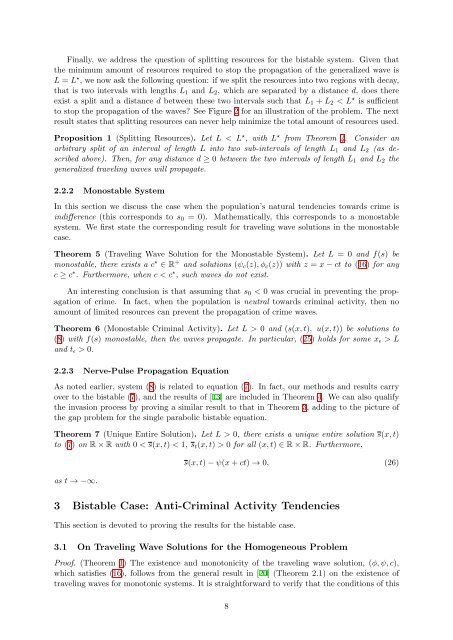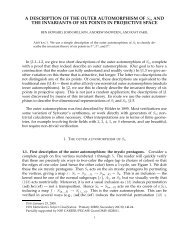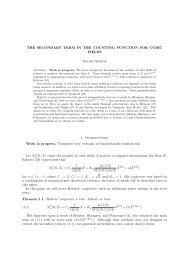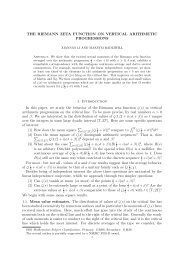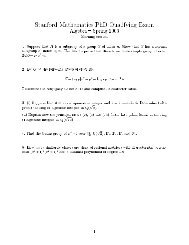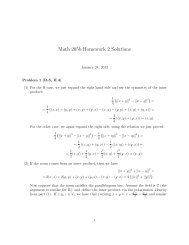Traveling Wave Solutions in a Reaction-Diffusion Model for Criminal ...
Traveling Wave Solutions in a Reaction-Diffusion Model for Criminal ...
Traveling Wave Solutions in a Reaction-Diffusion Model for Criminal ...
Create successful ePaper yourself
Turn your PDF publications into a flip-book with our unique Google optimized e-Paper software.
F<strong>in</strong>ally, we address the question of splitt<strong>in</strong>g resources <strong>for</strong> the bistable system. Given that<br />
the m<strong>in</strong>imum amount of resources required to stop the propagation of the generalized wave is<br />
L = L ⋆ , we now ask the follow<strong>in</strong>g question: if we split the resources <strong>in</strong>to two regions with decay,<br />
that is two <strong>in</strong>tervals with lengths L1 and L2, which are separated by a distance d, does there<br />
exist a split and a distance d between these two <strong>in</strong>tervals such that L1 + L2 < L ⋆ is sufficient<br />
to stop the propagation of the waves? See Figure 2 <strong>for</strong> an illustration of the problem. The next<br />
result states that splitt<strong>in</strong>g resources can never help m<strong>in</strong>imize the total amount of resources used.<br />
Proposition 1 (Splitt<strong>in</strong>g Resources). Let L < L ⋆ , with L ⋆ from Theorem 4. Consider an<br />
arbitrary split of an <strong>in</strong>terval of length L <strong>in</strong>to two sub-<strong>in</strong>tervals of length L1 and L2 (as described<br />
above). Then, <strong>for</strong> any distance d ≥ 0 between the two <strong>in</strong>tervals of length L1 and L2 the<br />
generalized travel<strong>in</strong>g waves will propagate.<br />
2.2.2 Monostable System<br />
In this section we discuss the case when the population’s natural tendencies towards crime is<br />
<strong>in</strong>difference (this corresponds to s0 = 0). Mathematically, this corresponds to a monostable<br />
system. We first state the correspond<strong>in</strong>g result <strong>for</strong> travel<strong>in</strong>g wave solutions <strong>in</strong> the monostable<br />
case.<br />
Theorem 5 (<strong>Travel<strong>in</strong>g</strong> <strong>Wave</strong> Solution <strong>for</strong> the Monostable System). Let L = 0 and f(s) be<br />
monostable, there exists a c ∗ ∈ R + and solutions (ψc(z), φc(z)) with z = x − ct to (16) <strong>for</strong> any<br />
c ≥ c ∗ . Furthermore, when c < c ∗ , such waves do not exist.<br />
An <strong>in</strong>terest<strong>in</strong>g conclusion is that assum<strong>in</strong>g that s0 < 0 was crucial <strong>in</strong> prevent<strong>in</strong>g the propagation<br />
of crime. In fact, when the population is neutral towards crim<strong>in</strong>al activity, then no<br />
amount of limited resources can prevent the propagation of crime waves.<br />
Theorem 6 (Monostable Crim<strong>in</strong>al Activity). Let L > 0 and (s(x, t), u(x, t)) be solutions to<br />
(8) with f(s) monostable, then the waves propagate. In particular, (25) holds <strong>for</strong> some xɛ > L<br />
and tɛ > 0.<br />
2.2.3 Nerve-Pulse Propagation Equation<br />
As noted earlier, system (8) is related to equation (7). In fact, our methods and results carry<br />
over to the bistable (7), and the results of [13] are <strong>in</strong>cluded <strong>in</strong> Theorem 4. We can also qualify<br />
the <strong>in</strong>vasion process by prov<strong>in</strong>g a similar result to that <strong>in</strong> Theorem 3, add<strong>in</strong>g to the picture of<br />
the gap problem <strong>for</strong> the s<strong>in</strong>gle parabolic bistable equation.<br />
Theorem 7 (Unique Entire Solution). Let L > 0, there exists a unique entire solution s(x, t)<br />
to (7) on R × R with 0 < s(x, t) < 1, st(x, t) > 0 <strong>for</strong> all (x, t) ∈ R × R. Furthermore,<br />
as t → −∞.<br />
s(x, t) − ψ(x + ct) → 0, (26)<br />
3 Bistable Case: Anti-Crim<strong>in</strong>al Activity Tendencies<br />
This section is devoted to prov<strong>in</strong>g the results <strong>for</strong> the bistable case.<br />
3.1 On <strong>Travel<strong>in</strong>g</strong> <strong>Wave</strong> <strong>Solutions</strong> <strong>for</strong> the Homogeneous Problem<br />
Proof. (Theorem 1) The existence and monotonicity of the travel<strong>in</strong>g wave solution, (φ, ψ, c),<br />
which satisfies (16), follows from the general result <strong>in</strong> [20] (Theorem 2.1) on the existence of<br />
travel<strong>in</strong>g waves <strong>for</strong> monotonic systems. It is straight<strong>for</strong>ward to verify that the conditions of this<br />
8


